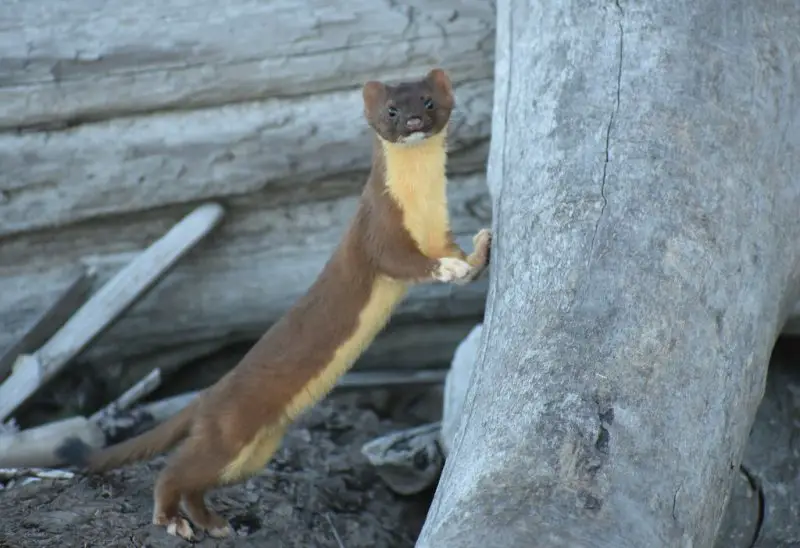Nebraska’s diverse landscapes, from the rolling prairies to the rugged Sandhills, offer a variety of habitats that support numerous wildlife species. The state’s mixture of grasslands, wetlands, and forested areas creates ideal conditions for both common and elusive animals.
Among Nebraska’s fascinating wildlife are two members of the mustelid family, the long-tailed weasel (Neogale frenata) and the plains least weasel (Mustela nivalis). These small carnivores are known for their agility, keen hunting skills, and adaptability to different environments.
Although often difficult to spot, weasels play an essential role in maintaining ecological balance by controlling rodent populations. In this article, we will explore the distinctive characteristics, behaviors, and habitats of these two weasel species found across Nebraska.
Long-Tailed Weasel (Neogale frenata)

Identification and Physical Characteristics
The long-tailed weasel is among the larger weasel species found in North America, notable for its slender yet muscular build. Adult individuals typically measure between eleven and sixteen and a half inches in total length, with males generally larger than females.
Their long, flexible bodies are perfectly adapted for chasing prey through narrow burrows and dense vegetation. One of their most distinctive features is the tail, which is bushy and can account for nearly half of their overall length. The tail ends in a sharp black tip, which remains visible even during winter.
During winter, their cinnamon brown coat on the back and sides fades to a clean white, while the underparts maintain a yellowish-white hue. This transformation creates the classic ermine appearance that is highly valued in wildlife studies.
Behavior and Activity Patterns
Long-tailed weasels are primarily nocturnal, though they can occasionally be seen during daylight hours, especially in undisturbed areas. They are highly solitary outside of the breeding season, with males and females maintaining separate territories.
Known for their incredible agility and speed, long-tailed weasels can navigate complex terrain and pursue prey with remarkable efficiency. They often freeze in place or hide at the first sign of danger. Their hunting behavior is impressive, as they can enter rodent burrows or climb low vegetation in pursuit of prey.
Diet and Hunting Techniques
As obligate carnivores, long-tailed weasels feed primarily on small mammals, with voles, mice, and rabbits forming the bulk of their diet. They also opportunistically consume birds, eggs, and insects.
Their hunting strategy relies on stealth and rapid bursts of movement. A long-tailed weasel will stalk its prey quietly, approaching from behind before delivering a quick, lethal bite to the neck. Their small size and flexible bodies allow them to infiltrate burrows and tight spaces, making them extremely efficient predators.
Reproduction and Life Cycle
Mating typically occurs in late summer, but females often exhibit delayed implantation. The fertilized egg does not immediately attach to the uterine wall, allowing them to time the birth of their young for the following spring.
Litters usually consist of three to ten kits, which are born blind and helpless. The mother provides intensive care, nursing them until they are capable of leaving the den to explore and hunt independently at about eight weeks of age.
Habitat and Distribution in Nebraska
In Nebraska, long-tailed weasels occupy a broad range of habitats. They can be found in wooded areas, grasslands, and even agricultural fields where rodents are plentiful.
These weasels prefer areas that provide both cover and hunting opportunities, such as thickets, fence rows, and brushy edges along streams or wetlands. Males typically maintain larger territories than females, sometimes overlapping with several female ranges, while females tend to stay closer to areas rich in prey and shelter.
Fun Fact
Despite their small size, long-tailed weasels are formidable hunters capable of taking down prey much larger than themselves. Their strength, speed, and tenacity make them one of the most effective small predators in Nebraska, and they play a critical role in controlling rodent populations. Observing one in the wild is a rare treat, highlighting the incredible survival skills of this stealthy carnivore.
Plains Least Weasel (Mustela nivalis)

Identification and Physical Characteristics
The plains least weasel is the smallest carnivorous mammal in North America, known for its compact and slender body. Adult individuals typically measure between four and ten inches in total length, with males slightly larger than females.
Their fur is brown on the back and white on the underside, separated by a clear, straight line. During winter, the coat turns completely white to blend with snowy environments, with only the tip of the tail remaining black. This seasonal change helps the weasel remain camouflaged from both predators and prey.
Behavior and Activity Patterns
Like their larger relatives, plains least weasels are primarily nocturnal, although they may also be active during daylight in quiet areas. They are solitary and highly territorial animals, often using scent markings to communicate boundaries and reproductive status to others.
Their small size allows them to move swiftly through dense vegetation and narrow burrows in pursuit of prey. They are extremely alert and cautious, quickly seeking cover at the first sign of danger.
Diet and Hunting Techniques
Plains least weasels feed mainly on small rodents, including mice and voles. They are relentless hunters, relying on speed, stealth, and precision to ambush prey.
They often enter burrows to capture prey from within, taking advantage of their small size to access areas that larger predators cannot. Their high metabolism means they must eat almost constantly, consuming up to their body weight in food every day.
Reproduction and Life Cycle
Breeding typically occurs in late spring, with females giving birth to litters of three to six kits. The young are born blind and helpless, fully dependent on their mother for warmth, protection, and nourishment.
By the time they reach around eight weeks of age, the kits are strong and coordinated enough to begin exploring their environment and learning to hunt under their mother’s guidance.
Habitat and Distribution in Nebraska
In Nebraska, plains least weasels are usually found in grasslands, prairies, and agricultural fields. They prefer areas with dense vegetation that provide cover and abundant prey.
While their distribution is more limited compared to the long-tailed weasel, they remain present across various parts of the state, thriving in regions where rodent populations are plentiful.
Fun Fact
Despite their diminutive size, plains least weasels are formidable hunters. They can take down prey several times their own weight, demonstrating remarkable efficiency and predatory skill. Their small size combined with their agility makes them one of the most effective small mammalian predators in Nebraska.
Comparative Overview
Feature |
Long-Tailed Weasel (Neogale frenata) |
Plains Least Weasel (Mustela nivalis) |
|---|---|---|
Size |
11–16.5 inches |
4–10 inches |
Weight |
3–12 ounces |
Approximately 0.9 ounce |
Fur Color |
Brown with yellowish-white underparts |
Brown back, white underside; white in winter |
Tail |
Long, bushy with black tip |
Short, black-tipped |
Habitat |
Wooded areas, grasslands, agricultural fields |
Grasslands, prairies, agricultural fields |
Diet |
Small mammals, birds, insects |
Small rodents |
Reproduction |
3–10 kits per litter |
3–6 kits per litter |
Fun Fact |
Can take down prey larger than themselves |
Efficient hunters despite small size |
Best Time and Places to Observe Weasels in Nebraska
Observing weasels in the wild can be challenging due to their small size, secretive behavior, and primarily nocturnal habits. The long-tailed weasel and plains least weasel are most active during dawn and dusk, which are the optimal times for spotting them. During these low-light periods, they emerge from their dens to hunt, giving keen wildlife observers a better chance to catch sight of their swift movements and hunting behaviors.
Weasels are highly adaptable but prefer habitats that provide cover and abundant prey. In Nebraska, ideal locations include the edges of grasslands, prairies, and agricultural fields, where rodent populations are dense. Wooded areas, thickets, brushy fence rows, and the margins of streams or wetlands are also excellent places to watch, as these areas offer shelter and pathways for their hunting excursions.
Patience and quiet observation are key. Using binoculars from a distance helps avoid disturbing these skittish animals. Trails along the Sandhills, river valleys, and protected natural reserves can also increase the likelihood of sightings, especially in regions where human activity is limited. By visiting these habitats during dawn or dusk, observers may witness the remarkable agility and stealth of Nebraska’s weasels in their natural environment.
Conclusion
Nebraska’s ecosystems are enriched by the presence of the long-tailed and plains least weasels. These small carnivores, though often overlooked, play vital roles in controlling rodent populations and maintaining ecological balance. Their unique behaviors, adaptations, and contributions to the environment make them fascinating subjects of study and appreciation.
For those interested in observing these elusive creatures, it’s best to venture into Nebraska’s diverse habitats during dawn or dusk, when they are most active. Remember to respect their natural behaviors and habitats, ensuring these remarkable animals continue to thrive in the wild.
Frequently Asked Questions About Weasels in Nebraska
What types of weasels are found in Nebraska?
Nebraska is home to two main species of weasels: the long-tailed weasel (Neogale frenata) and the plains least weasel (Mustela nivalis). Both species are small carnivores that help control rodent populations and can be found across grasslands, prairies, wooded areas, and agricultural fields.
How can I identify a long-tailed weasel versus a plains least weasel?
Long-tailed weasels are larger, measuring between eleven and sixteen and a half inches in length, with a bushy tail that has a distinct black tip. Their fur is cinnamon brown in summer and turns white in winter except for the tail tip. Plains least weasels are smaller, only four to ten inches long, with a straight demarcation between the brown back and white underside. In winter, their coat becomes entirely white except for the tail tip.
When is the best time to see weasels in the wild?
Weasels are primarily active during dawn and dusk. These low-light periods are ideal for observing their hunting and foraging behavior. Although they are mostly nocturnal, they can occasionally be seen during the day in undisturbed areas.
Where are weasels most likely to be spotted in Nebraska?
Long-tailed and plains least weasels prefer habitats with dense vegetation and cover. Good locations include grasslands, prairies, agricultural fields, woodlands, brushy fence rows, and edges of streams or wetlands. Observers have better chances in protected natural areas or regions with minimal human disturbance.
What do weasels eat in Nebraska?
Both species are carnivorous, primarily hunting small mammals such as mice, voles, and rabbits. They may also consume birds, eggs, and insects. Their hunting techniques rely on speed, stealth, and precision, often entering burrows to catch prey.
How do weasels reproduce and care for their young?
Long-tailed weasels breed in late summer, often using delayed implantation to time the birth for spring. Litters consist of three to ten kits. Plains least weasels breed in late spring, producing three to six kits. In both species, the young are born blind and helpless, relying entirely on the mother until they can hunt independently.
Are weasels dangerous to humans or pets?
Weasels are generally not dangerous to humans. They are small, secretive, and avoid contact with people. However, they are natural predators, so small pets like rodents or poultry may be at risk if left unprotected.
Fun fact about Nebraska weasels
Despite their small size, both long-tailed and plains least weasels are fierce hunters capable of taking down prey much larger than themselves. Their agility, speed, and hunting skills make them remarkable predators in Nebraska’s ecosystems.






